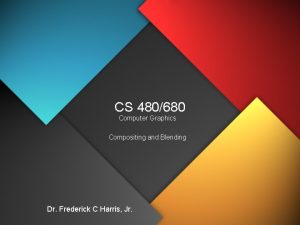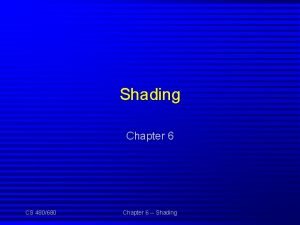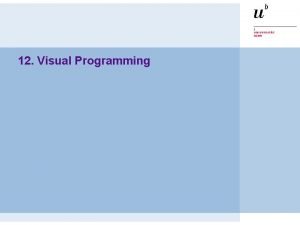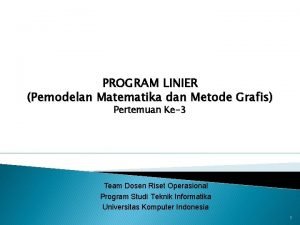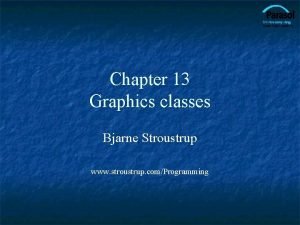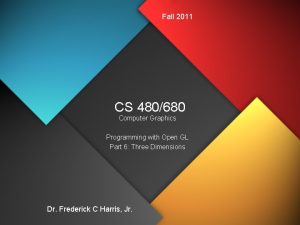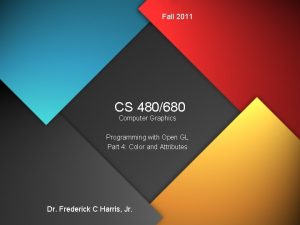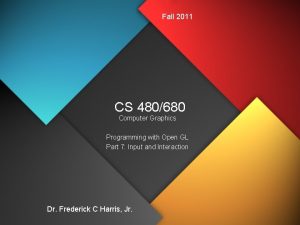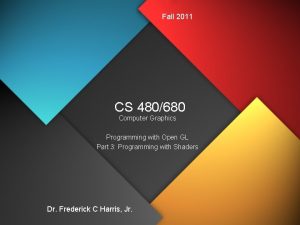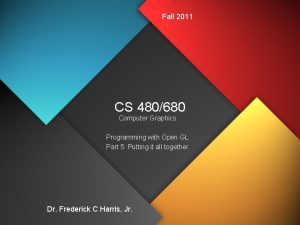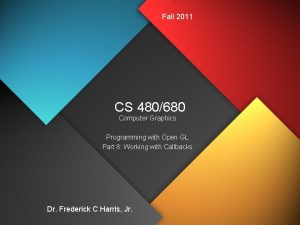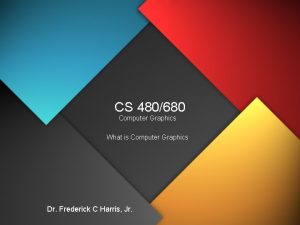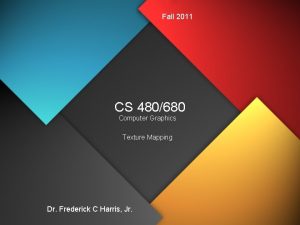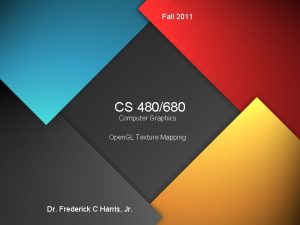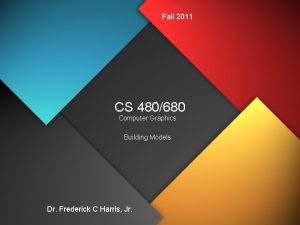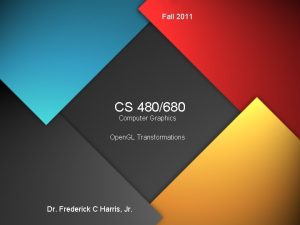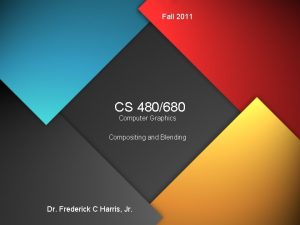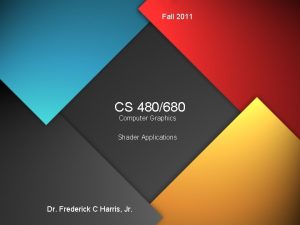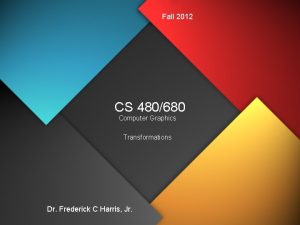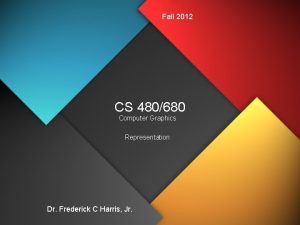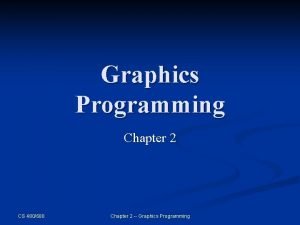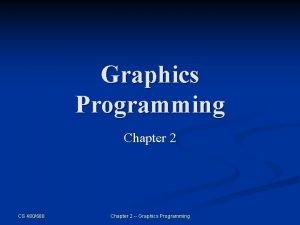Fall 2011 CS 480680 Computer Graphics Programming with



















- Slides: 19

Fall 2011 CS 480/680 Computer Graphics Programming with Open GL Part 2: Complete Programs Dr. Frederick C Harris, Jr.

Objectives • Build a complete first program – Introduce shaders – Introduce a standard program structure • Simple viewing – Two-dimensional viewing as a special case of three-dimensional viewing • Initialization steps and program structure

Program Structure • Most Open. GL programs have a similar structure that consists of the following functions – main(): • specifies the callback functions • opens one or more windows with the required properties • enters event loop (last executable statement) – init(): sets the state variables • Viewing • Attributes – init. Shader(): read, compile and link shaders – callbacks • Display function • Input and window functions

simple. c revisited • main() function similar to last lecture – Mostly GLUT functions • init() will allow more flexibility for colors • init. Shader() will hides details of setting up shaders for now • Key issue is that we must form a data array to send to GPU and then render it

main. c #include <GL/glew. h> #include <GL/glut. h> includes gl. h int main(int argc, char** argv) { glut. Init(&argc, argv); glut. Init. Display. Mode(GLUT_SINGLE|GLUT_RGB); glut. Init. Window. Size(500, 500); glut. Init. Window. Position(0, 0); specify window properties glut. Create. Window("simple"); glut. Display. Func(mydisplay); display callback glew. Init(); set Open. GL state and initialize shaders init(); glut. Main. Loop(); enter event loop }

GLUT functions • glut. Init allows application to get command line arguments and initializes system • glu. Init. Display. Mode requests properties for the window (the rendering context) – RGB color – Single buffering – Properties logically ORed together • • • glut. Window. Size in pixels glut. Window. Position from top-left corner of display glut. Create. Window create window with title “simple” glut. Display. Func display callback glut. Main. Loop enter infinite event loop

Immediate Mode Graphics • Geometry specified by vertices – Locations in space (2 or 3 dimensional) – Points, lines, circles, polygons, curves, surfaces • Immediate mode – Each time a vertex is specified in application, its location is sent to the GPU – Old style uses gl. Vertex – Creates bottleneck between CPU and GPU – Removed from Open. GL 3. 1

Retained Mode Graphics • Put all vertex and attribute data in array • Send array to GPU to be rendered immediately • Almost OK but problem is we would have to send array over each time we need another render of it • Better to send array over and store on GPU for multiple renderings

Display Callback • Once we get data to GLU, we can initiate the rendering with a simple callback void mydisplay() { gl. Clear(GL_COLOR_BUFFER_BIT); gl. Draw. Arrays(GL_TRIANGLES, 0, 3); gl. Flush(); } • Arrays are buffer objects that contain vertex arrays

Vertex Arrays • Vertices can have many attributes – Position – Color – Texture Coordinates – Application data • A vertex array holds these data • Using types in vec. h point 2 vertices[3] = {point 2(0. 0, 0. 0), point 2(0. 0, 1. 0), point 2(1. 0, 1. 0)};

Vertex Array Object • Bundles all vertex data (positions, colors, . . , ) • Get name for buffer then bind Glunit abuffer; gl. Gen. Vertex. Arrays(1, &abuffer); gl. Bind. Vertex. Array(abuffer); • At this point we have a current vertex array but no contents • Use of gl. Bind. Vertex. Array lets us switch between VBOs

Buffer Object • Buffers objects allow us to transfer large amounts of data to the GPU • Need to create, bind and identify data Gluint buffer; gl. Gen. Buffers(1, &buffer); gl. Bind. Buffer(GL_ARRAY_BUFFER, buffer); gl. Buffer. Data(GL_ARRAY_BUFFER, sizeof(points), points); • Data in current vertex array is sent to GPU

Initialization • Vertex array objects and buffer objects can be set up in init() • Also set clear color and other Ope. GL parameters • Also set up shaders as part of initialization – Read – Compile – Link • First let’s consider a few other issues

Coordinate Systems • The units in points are determined by the application and are called object, world, model or problem coordinates • Viewing specifications usually are also in object coordinates • Eventually pixels will be produced in window coordinates • Open. GL also uses some internal representations that usually are not visible to the application but are important in the shaders

Open. GL Camera • Open. GL places a camera at the origin in object space pointing in the negative z direction • The default viewing volume is a box centered at the origin with sides of length 2

Orthographic Viewing In the default orthographic view, points are projected forward along the z axis onto the plane z=0 z=0

Viewports • Do not have use the entire window for the image: gl. Viewport(x, y, w, h) • Values in pixels (window coordinates)

Transformations and Viewing • In Open. GL, projection is carried out by a projection matrix (transformation) • Transformation functions are also used for changes in coordinate systems • Pre 3. 0 Open. GL had a set of transformation functions which have been deprecated • Three choices – Application code – GLSL functions – vec. h and mat. h

 480680
480680 480680
480680 480680
480680 Most of the graphics monitors today operate as
Most of the graphics monitors today operate as Computer graphics introduction ppt
Computer graphics introduction ppt Programming raster display system in computer graphics
Programming raster display system in computer graphics Realitykit example
Realitykit example Math for graphics programming
Math for graphics programming Programming graphics
Programming graphics Perbedaan linear programming dan integer programming
Perbedaan linear programming dan integer programming Greedy algorithm vs dynamic programming
Greedy algorithm vs dynamic programming System programming vs application programming
System programming vs application programming Linear vs integer programming
Linear vs integer programming Definisi linear
Definisi linear Angel computer graphics
Angel computer graphics Types of projection in computer graphics
Types of projection in computer graphics What is video display devices in computer graphics
What is video display devices in computer graphics Two dimensional viewing
Two dimensional viewing Shear transformation in computer graphics
Shear transformation in computer graphics Glsl asin
Glsl asin
